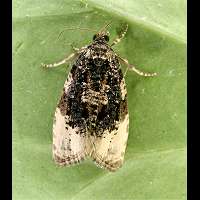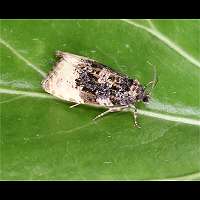Long Cloaked Marble (Hedya ochroleucana)
The Long Cloaked Marble, also known as the Early Fruit Moth, Plum Tortricid or Plum Tortrix, is an attractive and not very variable species. The front part of the upperwing is blackblueish marbled. The last part however is of a creamy colour with darker patches. These patches are pink in very fresh specimens, but that colour quickly fades through salmoncolours and light reddish brown into a yellowish grey. The hindwing is greyish, usually light grey in males and dark grey in females. The legs are creamy with grey rings. The antennae are greyish brown with a solid grey patch, usually some half way from the base or near the top. Males and females are identical, except for the colours of the hindwings. The Plum Tortrix useually reaches a wingspan of anything between 16 and 21 mm.
The eggs are deposited in small groups of two or three on the upperside of the leaves of the foodplants in july and august. After hatching the caterpillars spin together two or more leaves. But sometimes all leaves of a fresh sprout are spun tohether. These larvae are dark green and have a strikingly black head. They reach a length of 16 to 18mm. Pupation takes place in May and June. The black pupa is at the same place the larva used to be before pupation. Two or three weeks later the adults leave their pupa. The main time to see this species flying about is June and July. The species has a few hostplants only, the first and main being: roses, both the wild and the cultivated varieties. The damage they do is not very intense, but attacking developing sprouts they can cause the rose plants to look simply miserable and infested sprouts have fewer or no flowers. Sometimes this species also appears on apple trees, where they do no real damage.
This species flies by night exclusively, especially before midnight and is easily attrated by light. The Long Cloaked Marble species has a vast distribution area: from Europe through Russia, China, Korea and Japan to Northern America, but it hardly ever appears in great numbers.
The Long Cloaked Marble, also known as the Early Fruit Moth, Plum Tortricid or Plum Tortrix, is an attractive and not very variable species. The front part of the upperwing is blackblueish marbled. The last part however is of a creamy colour with darker patches. These patches are pink in very fresh specimens, but that colour quickly fades through salmoncolours and light reddish brown into a yellowish grey. The hindwing is greyish, usually light grey in males and dark grey in females. The legs are creamy with grey rings. The antennae are greyish brown with a solid grey patch, usually some half way from the base or near the top. Males and females are identical, except for the colours of the hindwings. The Plum Tortrix useually reaches a wingspan of anything between 16 and 21 mm.
The eggs are deposited in small groups of two or three on the upperside of the leaves of the foodplants in july and august. After hatching the caterpillars spin together two or more leaves. But sometimes all leaves of a fresh sprout are spun tohether. These larvae are dark green and have a strikingly black head. They reach a length of 16 to 18mm. Pupation takes place in May and June. The black pupa is at the same place the larva used to be before pupation. Two or three weeks later the adults leave their pupa. The main time to see this species flying about is June and July. The species has a few hostplants only, the first and main being: roses, both the wild and the cultivated varieties. The damage they do is not very intense, but attacking developing sprouts they can cause the rose plants to look simply miserable and infested sprouts have fewer or no flowers. Sometimes this species also appears on apple trees, where they do no real damage.
This species flies by night exclusively, especially before midnight and is easily attrated by light. The Long Cloaked Marble species has a vast distribution area: from Europe through Russia, China, Korea and Japan to Northern America, but it hardly ever appears in great numbers.





